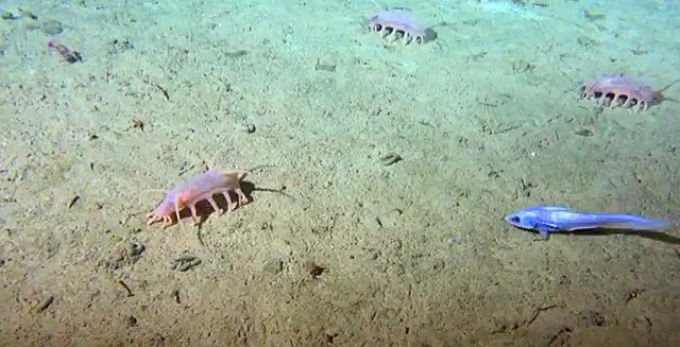Dec 4 2018
More than 2 miles below the surface of the ocean, many creatures, including fishes, worms, and microbes, of all shapes and sizes thrive. At these dark depths, these creatures depend on the transport of dead and decomposing matter from the surface or marine snow for their food.
 Many deep-sea animals at Station M live off of debris sinking down from above. The carbon carried into the deep by this debris is an important factor in global climate models. (Image credit: 2017 MBARI)
Many deep-sea animals at Station M live off of debris sinking down from above. The carbon carried into the deep by this debris is an important factor in global climate models. (Image credit: 2017 MBARI)
Up close to the surface of the sea, atmospheric carbon dioxide is integrated into the bodies of tiny algae as well as into the animals that consume them. When these organisms die, they sink to the bottom of the sea, taking carbon with them.
However, this carbon supply to the deep sea is not stable. Sometimes, during extremely short “pulse” events, months’ to years’ worth of marine snow reaches the chasm.
In the latest study reported in the Proceedings of the National Academy of Sciences (PNAS), researchers from Monterey Bay Aquarium Research Institute (MBARI) and their collaborators demonstrated that pulse events off the coast of California have increased considerably, and they also showed that such episodes are not well represented in worldwide climate models, despite being very crucial to the carbon cycle.
Over the last 29 years, Ken Smith, Senior Scientist at MBARI, has examined the way deep-sea communities react to changing carbon supply at Station M—a deep-sea research site. This long-term monitoring site stretches to 4000 m (2.5 miles) below the surface of the ocean and spans 220 km (124 miles) off the coast of California. This is the one and only deep-sea site in the globe where constant supply and demand of carbon are documented comprehensively as a time series.
At Station M, scientists use a set of autonomous instruments to examine the pulse events and their significant effects on deep-sea biota. Every 10 days, two sets of sediment traps, which are suspended 50 and 600 m above the seabed, collect the sinking marine snow. Time-lapse cameras installed on the bottom take photographs of the seafloor every hour, aiding researchers to identify changes in animal communities and variations in the amounts of marine snow.
At Station M, Benthic Rover—MBARI’s autonomous underwater vehicle resembling the size of a compact car—has crawled 11 km (7 miles) across the seafloor. It determines the consumption of oxygen by animals and microbes dwelling at the bottom of the sea, thus enabling researchers to estimate the amount of food (carbon) that is being consumed.
When huge amounts of marine snow reached the sediment traps at Station M, the PNAS study concentrated on six periods from 2011 to 2017. When compared to non-pulse days, four times more carbon accumulated at the bottom of the sea every day at the time of these episodic pulse events.
In comparison to the first two decades of the time-series, pulse events turned out to be more prevalent after 2011. Among the total carbon that accumulated at the sediment traps at 3400 m depth between 2011 and 2017, more than 40% arrived at the time of the pulse events.
These events are becoming a much bigger part of the carbon cycle.
Christine Huffard, Marine Biologist and Study Co-Author, MBARI.
In effect, as these pulse events occur more frequently and have become larger, investigators had to increase the size of the collection cups utilized in their sediment traps.
In global climate models, the pulses of food (and carbon) that reach the deep sea are not presently taken into consideration. The “Martin curve” formula, based on the conditions of the sea surface like water temperature, is extensively used for estimating the amount of carbon that reaches the deep sea. Along with her coauthors, Huffard discovered that while the Martin curve corresponded well with their data on non-pulse days, it rather underestimated the amount of carbon arriving at the time of pulse events by 80%.
In total the Martin curve estimated only half the deep-sea carbon that we measured.
Christine Huffard, Marine Biologist and Study Co-Author, MBARI.
These new findings hold implications for how the Martin curve and analogous models are used for preparing global carbon budget estimates for the Intergovernmental Panel on Climate Change Assessment Reports.
“We need to find a way to evolve such models so that they can capture these events, given their overall importance,” stated Huffard.
Next, the researchers will explore separate pulse events in a closer manner. According to Huffard, there are several questions that remain unanswered.
What makes each pulse different? Why are they so much more prevalent now than previously? What surface conditions lead to their formation? If we understand that, we can possibly model pulses from satellite data, so our global models can more accurately predict global carbon budgets. We would love to have 50 Station Ms all over the world, but we can’t. Realistically we need to model this using the global coverage provided by satellites.
Christine Huffard, Marine Biologist and Study Co-Author, MBARI.